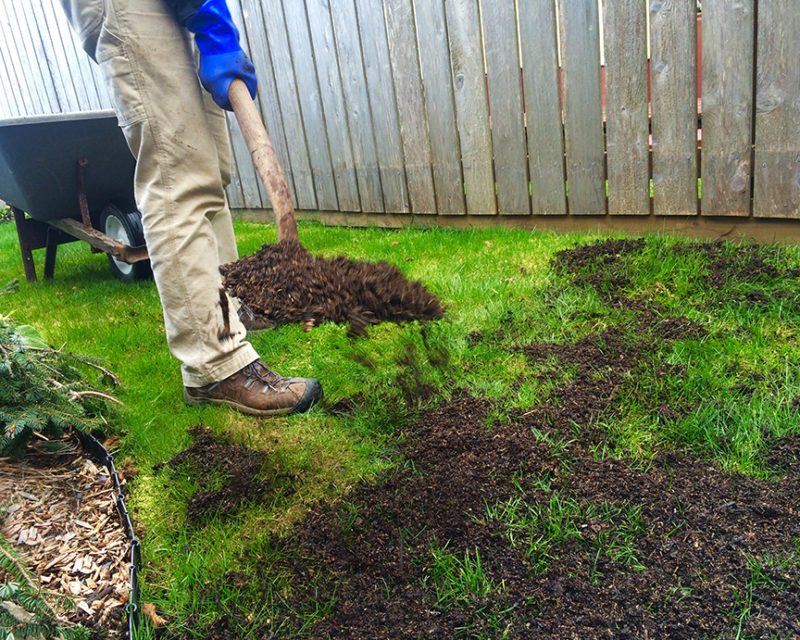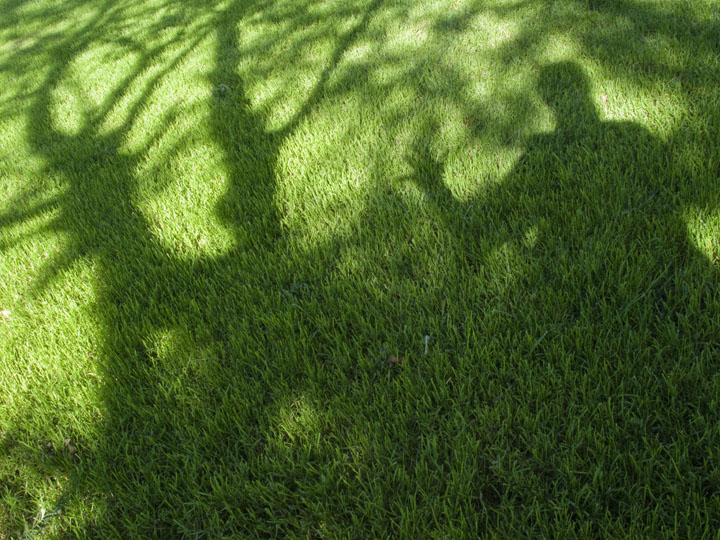Don’t you just love wriggling your toes in soft, green grass? Me, too. Until the day I went to a park and watched kids playing frisbee. They leaped high to snatch the frisbee and then touched down on the grass. Barefoot. I cringed because I knew the lawn had been treated with chemicals. When it comes to lawn care, most Americans follow a “more is better” attitude. Over-fertilizing to the tune of 3 million tons per year.
But what else can you do to keep your grass green?
Feed your lawn with the best lawn fertilizer money can’t buy. That’s what.
I live in Kodiak, Alaska. We jumpstart our lawn every spring and maintain it through the year, without chemicals.
If we can do it, you can, too.
Getting there was a challenge
We started our lawn from seed on a base of peat moss, shredded kelp, and compost. (Your lawn might differ, but that’s OK). It took some experimenting to get where we are now because we had a few things going against us. I’m sure you know the feeling.
First, Kodiak’s climate is classified as a “temperate rainforest” which means wet. Second, the soil is quite acidic (low pH) and lacks organic matter. Our lawn must withstand heavy rain, snow, cold winds that suck moisture out of leaves, and damaging freeze-thaw cycles.
Then there’s the pressure of many footprints: B&B guests, kids, grandkids, and dogs.
Still, the method I’m about to share is simple. And I’m confident it will work for your patch of green, wherever you live.
Let’s start with spring…
Green is beautiful
When spring arrives, thoughts turn to outside. You feel the need to do something. Many people grab a rake clean up winter debris. Twigs, branches, pine cones, litter, plastic toys, dog poop.
Start by giving your lawn a gentle combing with a leaf rake. If the ground is moist, step lightly. Treading on a soggy lawn is one of the worst things you can do. Better to wait until the turf has dried out and the ground is not so mushy.
Don’t tread on me
Here’s the deal. When you walk on a soggy lawn, you squeeze out the air between soil particles. Air pockets are critical to soil health. Without air “highways”, water and nutrients can’t reach the root zone. Water forms puddles. Then one day, you look at your lawn and wonder, “Why does it look so pathetic?”
Remember, turf grass thrives on the same kind of soil in your garden: Rich, well-drained soil, high in organic matter.
Rest assured that perfect, well-drained soil doesn’t come naturally in Kodiak, Alaska. Or anywhere else.
In our case, we’d moved into a new house with a yard as bare as the moon. So we had to create our lawn. And learn the good, the bad and the ugly about lawn care…
What is the best lawn fertilizer?
It’s easy being green, whether you apply organic or chemical fertilizers. So let’s look at the differences:
Organic fertilizers
Organic fertilizers enrich the soil which improves aeration and root growth. Which means your lawn:
- Survives drought and extreme weather conditions
- Holds onto nutrients longer
- Requires less maintenance
Sounds good?
Here’s an important lawn care tip: HOW you mow your lawn makes a big difference. Keep your mower blades sharp and leave your grass 3 inches longer. This improves your lawn’s health because the leaves of longer grass have more access to sunlight, which helps the grass grow thicker and create deeper roots.
Chemical fertilizers
Chemical fertilizers:
- Wash away in heavy rains
- Turn your grass into an enticing, Day-Glo green. But at a price.
- The toxic runoff ends up in lakes, streams, and ultimately the ocean
- Create a toxic playground for kids and pets
- Have been linked to cancer and poisonings. Kids are higher-risk.
As for the soil itself, chemical fertilizers damage soil by killing beneficial microorganisms, worms, and fungi with toxic salt buildup.
With an organic lawn, you’re not simply putting down fertilizers four times a year; you’re initiating cultural practices to nurture life in the soil, and in turn, the soil sustains the grass.
~ Paul Tukey, author of The Organic Lawn Care Manual
The one simple tip for every lawn
I have nothing to sell you. Nothing to gain by what I’m about to share. Except for the warm glow inside knowing you have a lawn that’s green, easy to maintain, organic, and safe for kids and pets.
So here it is: Spread sifted compost on your lawn.
That’s right. It’s the best lawn fertilizer in the world.
All it takes is an inch or two.

How often should you spread compost?
Twice a year when the lawn is relatively dry. Then add water. Rain or sprinkler.
What else, besides compost?
Think organic materials. It depends on what’s available in your location. In coastal Alaska, the list includes:
- Spreading a combination of peat moss and compost, or
- One part peat moss to 3 bags steer or cow manure, or
- Finished compost plus sifted kelp, or
- A manure-compost blend plus last year’s used potting soil
You can also mix in:
- Soybean meal
- Cottonseed meal
- Dried molasses
- Well-aged manure–like a good wine!
- Finely shredded leaves (leaf mulch)
- Compost
Blend ingredients in a wheelbarrow. Then dump piles of it on the lawn or broadcast it by the shovelful, as if feeding chickens.
Then spread it around with the backside of a steel rake or with a leaf rake with a combing, fluffing action.
Okay, your lawn will look horrible for a while. Maybe a couple weeks. The neighbors will think you’re crazy.
Then something magic happens. New, green shoots emerge and the brown stuff settles into the ground and disappears.
The best lawn fertilizer — I promise!
Your lawn will be ten times healthier. You don’t have to worry about your kids running around barefoot. And the neighbors will stop whispering behind your back.
Now it’s your turn.
Thanks for visiting. I hope this article is helpful.

P.S. I’d love to know what changes you make to lawn care. Drop a note below…
P.P.S. I’ve written a general overview of organic gardening: Organic gardening tips | Cool climate gardening | Alaska gardening tips
Marion Owen is a “Jill of All Trades,” with 30 years of experience as a teacher and columnist. She’s on a mission to help busy people enhance their daily lives. How? She “Readers’ Digests” topics such as photography, cooking, and organic gardening. Get her free 4-page “In Good Light: Photo Tips for Busy People” and feel recharged when taking pictures.

Thank you for sharing the informative article.
I’ve experimented with different brands and formulations to find the best lawn fertilizer to achieve lush green grass. My experience has shown that a balanced fertilizer with a nitrogen-rich formula promotes healthy growth. I recommend finding a fertilizer that suits your lawn needs and consistently applying it for a vibrant and thriving lawn.
Marion,
Peat moss on acid soil?
Visit your favorite coffee merchant and work a deal to cart off all their spent coffee grounds. Then mix the grounds with an equal amount of cracked corn, sometime called screenings. It’s like coarse corn meal. Spread this on the lawn. Then add a few hundred night crawlers, or whatever native worms you might have, here and there and everywhere. The living rototillers will multiply and enrich the soil better than almost any other method. They will plow miles of tiny air/water passageways, bringing nourishment deep into the soil.
Daryle Thomas
UVM EMG ’94
Hi Daryl!
Greetings from Kodiak… Yes, a little bit of peat moss when mixed with compost or other organics works just fine to hold moisture and provide tilth. Since it breaks down so quickly we consider it a jumpstart and one-time use. And yes, I LOVE to use coffee grounds. We run them through the compost. As for nighcrawlers, they are truly the unsung heroes of the soil. Great visual, the “living rototillers.” Humans would die without them, I’m sure. How much of a lawn do you have?
Actually,Marion, not much.
The bank is doing its best to foreclose. I am accepting unsolicited prayers that I will win a bit more than enough in the lottery and send the bums packing.
I do a fair amount of consulting … OPL, other people’s lawns. I’ve got an idea for growing food year around and preserving it. I am not opposed to allowing people to give me money to teach them how to grow what they eat. Much of Vermont’s “fresh” food travels about 50 hours from California behind a PeterBuilt. By the time it’s on the store shelf, another two days have past. With California drying up, there will be fewer leaves of lettuce at much higher prices. Stepping out one’s back door into one’s own green house to pluck a salad for dinner just makes more sense. It’s a perfect way to retire and live off the land … the fiddleheads should be out sometime this month.
Daryle